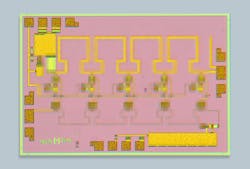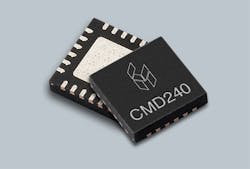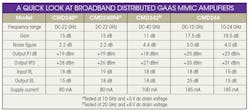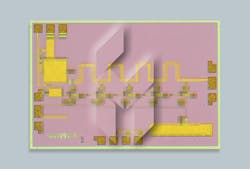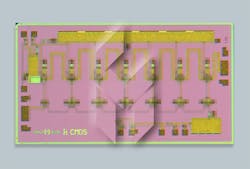Distributed Amplifier MMICs Boost Signals Over Wide Bands to 40 GHz
Download this article in PDF format.
Bandwidth is everything for some applications, including many communications systems, and boosting signal levels over broad bandwidths requires a special kind of amplifier. Typically, a distributed amplifier is used for such applications. As its name might suggest, gain is distributed among a number of transistors or active stages within the amplifier, such as field-effect transistors (FETs) in GaAs distributed amplifiers, to achieve level signal gain over wide bandwidths.
Commercially available amplifiers that deliver widely distributed gain with excellent gain flatness are the model CMD240 die, the CMD240P4 packaged amplifier (a CMD240 die mounted in a QFN package), the CMD242, and the CMD244 GaAs MMIC distributed amplifiers from Custom MMIC. These impedance-matched, 50-Ω dc-coupled amplifiers in their die and packaged forms are capable of bandwidths as wide as dc to 40 GHz in a single device (the model CMD242). They offer attractive combinations of low noise figures and flat-to-positive-sloping gain with frequency that remains stable with temperature.
Such amplifiers are invaluable for wideband communications receiver front ends. Their low noise figure doesn’t compromise receiver front-end sensitivity and they maintain sufficient gain to drive desired signals above the noise. In many cases, a single distributed amplifier may have sufficient bandwidth to serve multiple receive-frequency bands and receiver front ends if switched, helping to reduce the parts count on a portable radio design.
1. Model CMD240 is a GaAs MMIC distributed amplifier die with low noise figure and level gain from dc to 22 GHz.
For example, model CMD240 is a GaAs MMIC distributed amplifier die that delivers typically more than 15 dB gain while holding noise figure to typically 2.2 dB or less from dc to 22 GHz (Fig. 1). It provides +19 dBm typical output 1-dB compression point (output P1dB) and +28 dBm output third-order intercept point (IP3) across that wide frequency range when operating from +5 V dc drain voltage, −0.6 V dc gate voltage, and 80 mA typical current draw. Input return loss is typically 15 dB across the full dc to 22 GHz, while output return loss is typically 13 dB for the same range. The CMD240 has maximum rating of +20 dBm for input power.
As expected, there’s slight degradation in the noise-figure performance at the band edges, but with maximum noise figure of only about 3 dB at 20 GHz. The 22-GHz distributed amplifier is also available in QFN packaged form, as model CMD240P4 (Fig. 2).
2. The CMD240P is a QFN-packaged version of the CMD240 GaAs MMIC distributed amplifier for applications from dc to 22 GHz.
Spanning DC to 40 GHz
When even more bandwidth is needed, model CMD242 is a GaAs MMIC distributed amplifier die with enormous range of dc to 40 GHz. It provides more than 10.5 dB typical gain and typically less than 4.4 dB noise figure from dc to 40 GHz (see table). The broadband CMD242 achieves output P1 dB of +17.5 dBm from dc to 20 GHz and typically +19.0 dBm from 20 to 40 GHz. The amplifier’s output IP3 is typically +28 dBm from dc to 20 GHz and typically +26 dBm from 20 to 40 GHz.
It’s designed for maximum input power of +23 dBm. The wideband distributed amplifier is also rated for maximum power dissipation of 1.05 W and maximum thermal conductivity of 62.1ºC/W. The CMD242 GaAs MMIC die is available with a second voltage gate (Vgg2) for optional gain control (Fig. 3).
3. The CMD242 is a GaAs distributed amplifier die with typical gain of better than 10.5 dB across an impressive frequency range of dc to 40 GHz.
When more gain is needed, model CMD244 is a distributed driver amplifier die for applications from dc to 24 GHz (Fig. 4). It features a positive gain slope with frequency, with typical gain of 17.5 dB from dc to 10 GHz, rising to 18.5 dB from 10 to 24 GHz. The noise figure does rise somewhat with frequency, as expected, with typical noise figure of 3 dB from dc to 10 GHz, rising to typically 4 dB from 10 to 24 GHz. Input return loss is typically 18 dB from dc to 10 GHz and 15 dB from 10 to 24 GHz, while output return loss is typically 25 dB from dc to 10 GHz and 15 dB from 10 to 24 GHz. The output P1dB is normally +25 dBm from dc to 10 GHz and typically +23 dBm from 10 to 24 GHz. The output IP3 is typically +33 dBm from dc to 10 GHz and +31 dBm from 10 to 24 GHz.
4. Model CMD244 is a GaAs MMIC distributed driver amplifier die with high gain from dc to 24 GHz.
The CMD244 is rated for +15 dBm maximum input power. It’s also rated for maximum power dissipation of 2.4 W and maximum thermal conductivity of 26.82ºC/W. As with the CMD242, the CMD244 die comes with a second gate-voltage connection for optional gain control.
The GaAs MMIC distributed amplifier die are passivated for protection from moisture, and all of the distributed amplifiers are impedance-matched for broadband use in 50-Ω applications. They are characterized for operating temperatures from −55 to +85ºC. Datasheets for the GaAs MMIC packaged amplifier and die are complete with assembly and application guidelines, including warnings about the potential damage to GaAs devices from electrostatic discharge (ESD). Datasheets for all of the distributed amplifiers can be downloaded from www.custommmic.com/distributed-amplifiers/.
Custom MMIC, 300 Apollo Dr., Chelmsford, MA 01824; (978) 467-4290
About the Author
Jack Browne
Technical Contributor
Jack Browne, Technical Contributor, has worked in technical publishing for over 30 years. He managed the content and production of three technical journals while at the American Institute of Physics, including Medical Physics and the Journal of Vacuum Science & Technology. He has been a Publisher and Editor for Penton Media, started the firm’s Wireless Symposium & Exhibition trade show in 1993, and currently serves as Technical Contributor for that company's Microwaves & RF magazine. Browne, who holds a BS in Mathematics from City College of New York and BA degrees in English and Philosophy from Fordham University, is a member of the IEEE.

